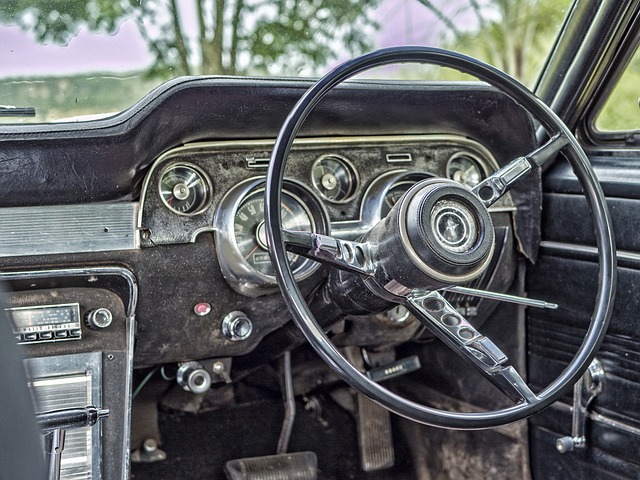Registering your car in California involves understanding specific requirements and gathering essential documents. This step-by-step guide walks you through the process, ensuring a smooth experience. First, familiarize yourself with California’s car registration rules, especially regarding the Vehicle Identification Number (VIN) verifier. Next, collect necessary paperwork, including proof of ownership and insurance. Visit a local DMV office to initiate the registration, completing the application accurately. Always verify your vehicle’s VIN for authenticity during the process.
- Understand California Car Registration Requirements
- Gather Necessary Documents for Vehicle Registration
- Visit a California Department of Motor Vehicles (DMV) Office
- Complete the Car Registration Application Process
- Verify Your Vehicle's VIN and Ensure Its Authenticity
Understand California Car Registration Requirements

Before registering your car in California, it’s crucial to understand the state’s specific requirements. One key step is ensuring your vehicle passes a thorough vin inspection. This involves verifying the Vehicle Identification Number (VIN), which acts as a unique fingerprint for your car, and checking its history to ensure it complies with safety and emission standards. In California, this process is typically done through the Department of Motor Vehicles (DMV).
A mobile vin verification or mobile vin inspection can also be an efficient option, allowing you to complete the necessary checks from the comfort of your own home or location. This modern approach streamlines the registration process, making it more convenient for California residents looking to get their vehicles registered promptly and without hassle.
Gather Necessary Documents for Vehicle Registration

Before you begin the registration process, make sure to gather all the essential documents required by the California Department of Motor Vehicles (DMV). One crucial document is the Vehicle Identification Number (VIN) verifier, which can be obtained through a mobile VIN inspection or a standard vin inspection. This unique identifier is vital for verifying the vehicle’s history and ensuring it complies with all necessary standards.
Additionally, you’ll need proof of insurance, a completed application form, and the appropriate fees. It’s recommended to check the DMV’s website for the latest list of required documents to avoid any delays during registration. A mobile VIN verification service can also be beneficial, as it allows you to quickly validate your vehicle’s information before submitting your application.
Visit a California Department of Motor Vehicles (DMV) Office

To start the registration process for your car in California, one of the first steps is to visit a local California Department of Motor Vehicles (DMV) office. Here, you’ll need to present several important documents and undergo various checks. A key part of this procedure involves using a vin verifier to ensure the vehicle’s identity and history are accurate. This process guarantees that the car has not been reported stolen and provides a detailed overview of its past, including any accidents or significant damage.
At the DMV, you can expect a friendly staff member to guide you through the registration procedures. They will assist you in verifying your mobile vin verifier data, which is crucial for completing the paperwork. This step simplifies the process, especially for those who prefer a more convenient mobile vin inspection option. By visiting a DMV office, you take a significant step towards legally registering your vehicle and ensuring it’s ready to hit California’s roads.
Complete the Car Registration Application Process

Completing the Car Registration Application Process is a straightforward step-by-step guide that every California driver should familiarize themselves with. It begins with gathering all necessary documents, including your vehicle’s registration papers, proof of insurance, and identification. The next crucial element is the Vehicle Identification Number (VIN) verification. This process can be completed through a mobile VIN inspection or by using an online VIN verifier to ensure the vehicle’s history is clear.
Once these foundational steps are taken care of, you’ll need to visit a California Department of Motor Vehicles (DMV) office or go online to fill out the registration application form. Provide accurate and up-to-date information about your vehicle and personal details. After submission, you might be required to schedule a mobile VIN inspection for further verification. This ensures that your car meets all legal requirements before its registration is approved.
Verify Your Vehicle's VIN and Ensure Its Authenticity

Before diving into the registration process, it’s crucial to verify your vehicle’s VIN (Vehicle Identification Number) and ensure its authenticity. This unique 17-character code is a key component in identifying your car and can be found on the vehicle’s certification label, usually located near the windshield or on the dash. A reliable vin verifier tool can help cross-check this information against manufacturer records to confirm the vehicle’s make, model, year, and even its history.
Using a mobile vin verification service or conducting a vin inspection can provide added peace of mind. These services offer accurate data on the vehicle’s condition, including any previous accidents, outstanding loans, or reported thefts. Ensuring your VIN is legitimate and matches the details on hand is an important step in the registration process, as it helps prevent fraud and ensures you’re providing accurate information to California’s Department of Motor Vehicles (DMV).
Registering your car in California is a straightforward process that requires understanding the state’s requirements, gathering essential documents, and visiting a local DMV office. By completing the application process and verifying your vehicle’s VIN with a reliable VIN verifier, you’ll have a valid registration in no time. Remember to keep your documentation up-to-date for smooth, legal operation of your vehicle.
